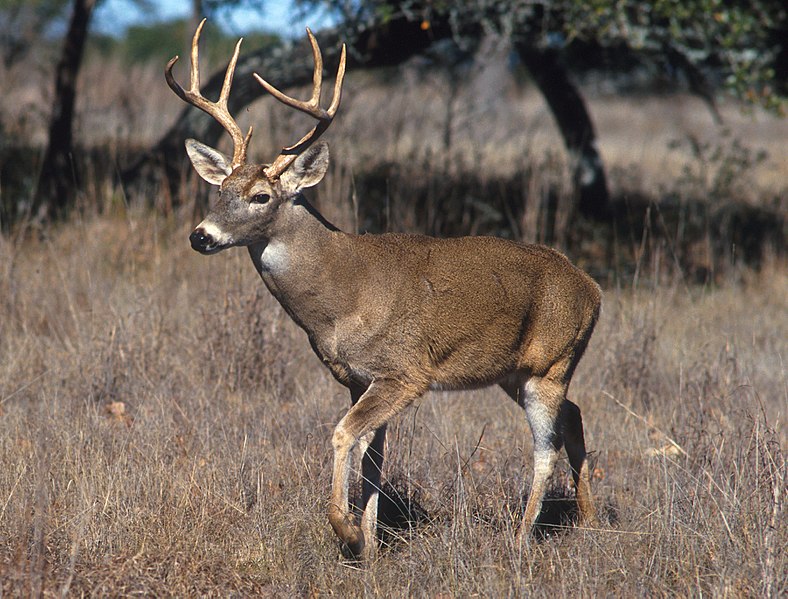You've heard of spring fever? Well in deer it's "autumn fever".
 |
| This spot is OK, but the grass is greener over there in Jane's yard... |
Here in North America the rut for white-tailed deer (Odocoileus virginianus) is about 1-3 months long and is triggered by the shortening days, like so many fall wildlife activities. The daylight period shortening is a dependable sign that winter is on its way, although the snow today is also a good sign. The specific timing is based on species gestation period - they time mating to coincide with a spring birth, so that temperatures and resources are available. In tropical areas, where deer don't have to think about things like snow and food availability, the rut can last a lot longer.
During the days leading up to the rut males will do some sparring, like boxers getting ready for the big fight. They also rub their antlers on the tree to lose the velvet (tree rubs) and make scrapes on the ground with their hooves (like Jane's front lawn). These last two activities are ways to mark their territory, advertise to the does and let the other bucks know just how awesome and powerful they are and who rules here. Later on they may do some actual fighting and sometimes they get stuck together and then they both die, so there's another reason that fighting is never the solution - they should use their words.
Deer don't live in big groups, they tend to form small female-led groups (matriarchal) and the bucks hang out with buddies. Because of this deer don't often come across each other and they use pheromones and signs to communicate - territories, locations and mood - which is particularly important in mating season when the future of the species depends on finding each other. The actual time a female is fertile can be very short - a day or two, so there's not a lot of time to waste wandering about looking for an acceptable buck. To shorten the time they wander around in random patches of cedar (I've wandered in a lot of cedar, it's hard to find stuff) they have created an intricate communication system of scrapes, branch licking, rubs and urine using pheromones from tarsal, forehead and pre-orbital glands.
 |
| SCENT GLANDS IN WHITE-TAILED DEER White-tailed deer have a number of external scent glands that are used primarily for communication with other deer. Gland secretions can describe a deer’s social status, breeding condition, health and warn other deer of potential danger.http://www.mnr.gov.on.ca/en/Business/FW/2ColumnSubPage/STDPROD_097096.html |
When a buck makes a scrape by pawing the ground he will then urinate on the tarsal gland (about halfway up the back leg) while pressing their legs together to create their own distinctive musky signature. Yes - they pee on their own legs, which when I pee in the woods I try to avoid at all costs. But then again I'm not trying to alert others to the fact I've peed there. When other deer come along they sniff this calling card and it provides an identity to the holder of the territory as well as health and dominance. If a doe likes what she smells she'll stick around for him to come back. If she's really into him then she pees on his pee as an enticing gesture. While I find this fascinating, I'm really glad it's not a part of the human mating system (for the average person at least). If another buck comes along he gets the same info and can then decide whether he wants to stick around and challenge for does or whether he should just move along and find his own spot. The younger, subordinate bucks do most of their scraping after the dominate males are done. Scrapes are usually accompanied by a "licking branch" - chewing and rubbing the forehead and preorbital (eye) glands on overhanging branches above the scrape.
Sorry to tell you Jane, the peak of the rut is usually the last few weeks of November, so there's still some lawn scraping to do yet.
More about those wacky deer:
http://outdoorcanada.ca/6633/hunting/big-game/decoding-deer-scrapes
http://www.fieldandstream.com/articles/rut-report/2010/10/buck-scrapes-turn-hot-10-days-prior-peak-rut
http://bowsite.com/bowsite/features/armchair_biologist/deerscrapes/deerscrapes.html
http://www.hww.ca/en/species/mammals/white-tailed-deer.html
http://www.mnr.gov.on.ca/en/Business/FW/2ColumnSubPage/STDPROD_097096.html


Very interesting about deer - they seem to have to do to a lot of trouble at this time of year!
ReplyDelete